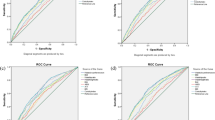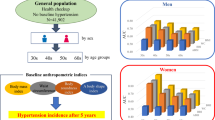Abstract
OBJECTIVE: To investigate which of six anthropometric indices was most strongly associated with elevated blood pressure and frank hypertension in a representative population sample of young and middle-aged British adults. SUBJECTS: A representative random sample of British adults (2712 men and 3279 women) aged between 18 and 64 y, who were resident in England, Scotland and Wales, were studied in the 1984–85 Health and Lifestyle Survey. MEASUREMENTS: Following an interview where demographic, health and lifestyle details were recorded, measurements of height, weight and waist and hip circumference were made by a nurse at a home visit, where blood pressure and medication to control blood pressure were also recorded. BMI and the ratios of waist circumference to height (WHTR) and waist circumference to hip (WHR) were calculated. Respondents with a blood pressure above 140 mm Hg (systolic) and/or 90 mm Hg (diastolic) or who were being treated for hypertension were classified as having elevated blood pressure. RESULTS: For men and women aged 18–39 and 40–64 y the prevalence of elevated blood pressure increased across the quintiles of BMI, weight, waist, WHTR and WHR was P<0.001 for each, with waist and WHTR having the highest odds ratios. Waist and height adjusted for each other were independently related to the prevalence of elevated blood pressure in 40–64 y old men and women. Height, on its own, was inversely related (P<0.05) only in the 40–64 y old men. The age adjusted partial correlations between systolic and diastolic blood pressure measurements and the measurements of BMI, weight, waist, WHTR and WHR were close and significant, P<0.001 for each. The ranking and significance of the correlations were hardly affected by excluding the treated hypertensives. CONCLUSIONS: The prevalence of elevated blood pressure was associated with quintiles of BMI, waist, WHTR, WHR and weight, with WHTR and WHR having the highest odds ratios. Waist and height were independently related to the prevalence of elevated blood pressure.
This is a preview of subscription content, access via your institution
Access options
Subscribe to this journal
Receive 12 print issues and online access
$259.00 per year
only $21.58 per issue
Buy this article
- Purchase on Springer Link
- Instant access to full article PDF
Prices may be subject to local taxes which are calculated during checkout
Similar content being viewed by others
Author information
Authors and Affiliations
Rights and permissions
About this article
Cite this article
Cox, B., Whichelow, M., Ashwell, M. et al. Association of anthropometric indices with elevated blood pressure in British adults. Int J Obes 21, 674–680 (1997). https://doi.org/10.1038/sj.ijo.0800459
Received:
Revised:
Accepted:
Issue Date:
DOI: https://doi.org/10.1038/sj.ijo.0800459
Keywords
This article is cited by
-
Identification of metabolic syndrome using phenotypes consisting of triglyceride levels with anthropometric indices in Korean adults
BMC Endocrine Disorders (2020)
-
Prediction of cold and heat patterns using anthropometric measures based on machine learning
Chinese Journal of Integrative Medicine (2018)
-
Waist-to-height ratio, a simple and practical index for assessing central fat distribution and metabolic risk in Japanese men and women
International Journal of Obesity (2003)
-
Health risks among Japanese men with moderate body mass index
International Journal of Obesity (2000)



